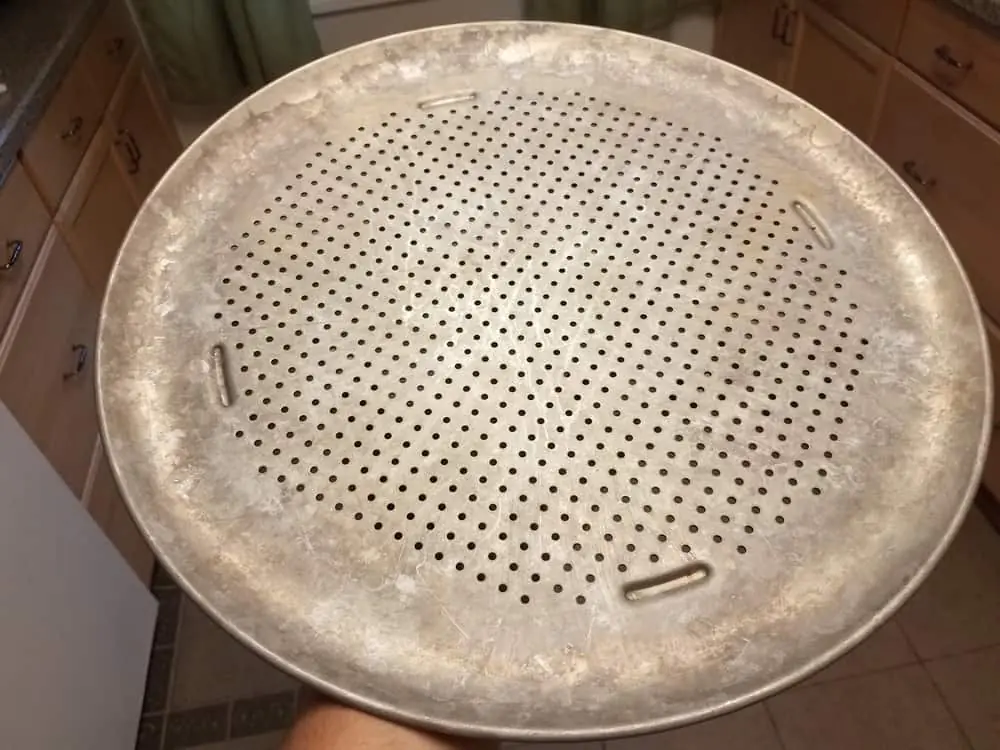A pizza pan with holes is better because it allows heat to escape faster, resulting in a hotter pizza. The holes also create air pockets, preventing the pizza from sticking to the pan and making it easier to clean.
Additionally, the holes promote air flow for even cooking, resulting in a crispy, brown crust and preventing the crust from getting soggy by allowing moisture to escape. A perforated pizza pan is a popular choice among pizza lovers, offering advantages over a traditional solid pan.
The presence of holes in the pan has a significant impact on the final outcome of the pizza. We will explore the benefits of using a pizza pan with holes versus a pan without holes. By understanding the purpose and advantages of a perforated pizza pan, you can make an informed decision on which type of pan to use for your next pizza-making adventure. So, let’s dive in and see what makes the holes in a pizza pan so crucial for achieving that perfect crust and deliciously baked pizza.
Benefits Of Pizza Pan With Holes
A pizza pan with holes offers multiple benefits compared to one without holes. Firstly, the holes allow heat to escape faster, resulting in a hotter pizza. Secondly, the holes create air pockets, preventing the pizza from sticking to the pan.
Lastly, cleaning becomes easier as there is less chance of food build-up on the surface.
A pizza pan with holes offers several advantages that contribute to an overall better pizza baking experience.
- Allows faster heat escape for a hotter pizza: The presence of holes in a pizza pan allows heat to escape faster during the baking process. This results in a pizza with a hotter and crisper crust, giving it that desired professional-quality texture.
- Creates air pockets to prevent sticking: The holes in the pan also serve to create air pockets between the dough and the surface of the pan. These air pockets help prevent the pizza dough from sticking to the pan, ensuring easy removal and a perfectly intact pizza.
- Easier to clean with less food build-up: With a pizza pan without holes, there is a higher chance of food build-up on the surface of the pan. In contrast, a pan with holes reduces the chances of food sticking and accumulating. This makes it much easier to clean and maintain the pan, saving you time and effort.
A pizza pan with holes enhances the overall pizza baking experience by allowing faster heat escape for a hotter pizza, creating air pockets to prevent sticking, and making it easier to clean with less food build-up. Investing in a pan with holes can result in consistently delicious and well-baked pizzas that are sure to impress your family and friends.
Advantages Of Pizza Pan Without Holes
The advantages of a pizza pan without holes are threefold. Firstly, it retains heat better, resulting in a perfectly cooked pizza with a crispy crust. Secondly, the lack of holes prevents any toppings from falling through, ensuring a delicious and intact pizza.
Lastly, cleaning is made easier as there are no crevices for food to get stuck in. So, if you’re looking for a crispy and hassle-free pizza experience, a pizza pan without holes is your best bet.
:
Pizza pans without holes have several advantages that make them a preferred choice for many home cooks and professional chefs. Whether you’re a pizza enthusiast or just love baking, here are the benefits of using a pizza pan without holes:
- Retains heat for a crispier crust:
- Without holes, the pan retains more heat, resulting in a crispier pizza crust.
- The heat is evenly distributed, ensuring that the entire crust is baked to perfection.
- Prevents toppings from falling through:
- A solid pizza pan acts as a barrier, preventing any toppings from slipping through the holes.
- You can load your pizza with generous amounts of toppings without worrying about a messy oven.
- Can be used for other baking purposes:
- Pizza pans without holes can be used for other baking purposes, such as baking cookies, pastries, or even reheating leftovers.
- The flat surface of the pan ensures even baking and prevents food from sticking.
- Easy to clean:
- With no holes, cleaning becomes a breeze as there is less chance of food debris getting stuck.
- You can simply wipe off any residue, and the pan is ready to be used again.
Using a pizza pan without holes offers the advantage of retaining heat for a crispier crust, preventing toppings from falling through, versatility for other baking purposes, and easier cleaning due to the absence of holes. It’s a practical choice for those who want a reliable, multi-purpose baking pan that delivers delicious results every time.
Happy baking!
Factors To Consider When Choosing Between Pizza Pan With Holes And No Holes
Pizza pan with holes allows heat to escape faster, resulting in a hotter pizza. The holes also create air pockets to prevent sticking and make cleaning easier. On the other hand, pizza pan with no holes promotes even cooking for a crispy, brown crust and prevents crusts from getting soggy.
Pizza Crust Preference (Thick Or Thin):
- If you prefer a thick and fluffy crust, a pizza pan with no holes is recommended. The solid surface helps retain moisture and promotes a softer texture.
- On the other hand, if you enjoy a thin and crispy crust, a pizza pan with holes is the way to go. The holes allow heat to circulate evenly, resulting in a crispier crust.
Desired Level Of Crispiness:
- If you like your pizza crust to be perfectly crispy, a pizza pan with holes is ideal. The holes allow moisture to escape, resulting in a crispy outer layer.
- However, if you prefer a softer crust with a slight chewiness, a pizza pan with no holes would be more suitable. The solid surface retains moisture, preventing excessive crispiness.
Type Of Toppings Being Used:
- For pizzas with heavy and juicy toppings, such as meat, vegetables, or extra cheese, a pizza pan with no holes is recommended. The solid surface helps contain the toppings and prevents any drippings from falling through.
- On the other hand, if you prefer lighter toppings, such as fresh herbs or thinly sliced vegetables, a pizza pan with holes can be beneficial. The holes allow steam to escape, preventing a soggy crust and ensuring even cooking of the toppings.
When choosing between a pizza pan with holes and one without, consider your pizza crust preference, desired level of crispiness, and the type of toppings being used. A pizza pan with holes is great for achieving a crispy crust and lighter toppings, while a pan with no holes is ideal for a softer crust and heavy toppings.
Ultimately, it comes down to personal preference and the type of pizza you want to create.
Tips For Using Pizza Pan With Holes
The use of a pizza pan with holes has several advantages over a pan without holes. The holes allow heat to escape, resulting in a hotter pizza, and create air pockets that prevent the pizza from sticking. Additionally, the holes make cleaning easier as there is less chance of food build-up.
:
Using a pizza pan with holes can greatly enhance your pizza baking experience. Here are some tips to keep in mind when using a pizza pan with holes:
- Preheat the pan before placing the pizza: Just like any other baking dish, it is important to preheat the pizza pan with holes. This helps in achieving a crispy crust and even cooking. Place the pan in the oven while it preheats to ensure it gets nice and hot.
- Use a lower oven temperature or shorter baking time: The holes in the pizza pan allow heat to circulate more efficiently, resulting in a faster cooking time. It is recommended to reduce the oven temperature by 25 degrees Fahrenheit or shorten the baking time accordingly. This will help prevent the pizza from burning or overcooking.
- Rotate the pizza during baking for even cooking: To ensure the pizza cooks evenly, it is a good idea to rotate it halfway through the baking process. This helps in achieving a golden brown crust and evenly melted cheese. Simply use a spatula or pair of tongs to turn the pizza around.
By following these tips, you can make the most out of your pizza pan with holes and achieve delicious, evenly cooked pizzas every time. Enjoy experimenting with different toppings and crust textures, knowing that your pizza will come out perfect from the oven.
Tips For Using Pizza Pan Without Holes
Using a pizza pan without holes has its advantages. It allows the pizza to heat evenly and creates a crispy crust. Additionally, the lack of holes makes it easier to clean as there is less food build-up on the surface.
:
Using a pizza pan without holes can still result in a delicious and crispy pizza. Follow these tips to achieve the best results:
- Preheat the pan for a longer period of time: Before placing the pizza on the pan, preheat it in the oven for at least 10 minutes. This helps the pan to reach the desired temperature, allowing the crust to cook evenly.
- Use a higher oven temperature or longer baking time: Since a pizza pan without holes may not promote as much air circulation, you may need to adjust the oven temperature or baking time to ensure a crispy crust. Increase the temperature by 25 degrees Fahrenheit or extend the baking time by a few minutes to achieve the desired level of crispiness.
- Avoid overloading with toppings to maintain crispiness: When using a pizza pan without holes, it’s important to refrain from overloading the pizza with toppings. Too many toppings can make the crust soggy and prevent it from getting crispy. Stick to a moderate amount of toppings to maintain the desired texture.
By following these tips, you can create a delicious and crispy pizza using a pan without holes. Remember to preheat the pan, adjust the oven temperature or baking time if needed, and avoid overloading with toppings for the best results.
Enjoy your homemade pizza!

Credit: mama-cucina.com
Frequently Asked Questions
Is A Pizza Pan With Holes Better?
A pizza pan with holes is better because it allows heat to escape faster, prevents sticking, and is easier to clean.
What Is The Purpose Of A Perforated Pizza Pan?
A perforated pizza pan promotes even cooking for a crispy, brown crust by allowing air flow. It also prevents soggy crusts by letting moisture escape.
What Type Of Pan Is Best For Pizza?
A perforated pizza pan is best for pizza because it allows heat to escape faster and creates air pockets, preventing sticking and making cleaning easier.
How Do You Keep Pizza From Sticking To A Perforated Pan?
Perforated pizza pans have holes that allow heat to escape faster, preventing the pizza from sticking and creating a crispier crust.
Conclusion
Perforated pizza pans offer several advantages over traditional pans without holes. The presence of holes in the pan allows heat to escape faster, resulting in a hotter and crispier pizza crust. Additionally, the holes create air pockets that help prevent the pizza from sticking to the pan, making it easier to remove the pizza without any damage.
Another benefit of perforated pizza pans is that they allow moisture to escape while the pizza is resting, preventing the crust from becoming soggy. This ensures that you get a perfectly cooked and delicious pizza every time. Furthermore, the presence of holes in the pan makes cleaning much easier.
There is less chance of food build-up on the surface, reducing the time and effort required for cleaning. If you want to achieve a crispy, golden-brown crust and avoid any sticking or sogginess, a perforated pizza pan is the way to go.
Its heat distribution and air circulation properties make it an essential tool for any pizza lover. So, consider investing in a perforated pizza pan and elevate your homemade pizza experience.

As the author of the “Ultimate Pizza Guide: Recipes, Tips & Secrets Revealed,” I’m dedicated to sharing my love for pizza and empowering others to create delicious homemade pizzas with ease. Join me on a journey to uncover the secrets to perfecting your pizza game!



